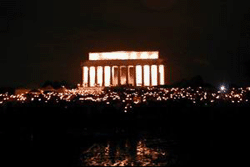Found 4305 matches from 1,400 records in about 0.1178 seconds for phone or e or geodeta.
Some pocket reference for troubled times:
 “Know Your Rights,” pamphlets and posters from the National Lawyer’s Guild on your rights of political protest intended to assist people who have already independently decided to engage in civil disobedience. Available in English, Spanish, Arabic, Farsi, Punjabi, and Portugeuse.
“Know Your Rights,” pamphlets and posters from the National Lawyer’s Guild on your rights of political protest intended to assist people who have already independently decided to engage in civil disobedience. Available in English, Spanish, Arabic, Farsi, Punjabi, and Portugeuse.- “Know Your Rights: What to Do If You’re Stopped by the Police, the FBI, the INS or the Customs Service” is published by the ACLU in English, Arabic, Spanish, Punjabi, Hindi, Urdu, Farsi, and Somali.
- From the Just Law Collective, legal handbooks for protestors, legal observers, and those on trial for political protest.
- From the Asian American Legal Defense and Education Fund, a small pamphlet on your rights and “special registration” with the INS for men who live in the U.S., are not citizens, and are of North Korean, Indonesian, Bangladeshi and Pakistani origin. In English, Korean, Indonesian.
- At May Day Books I picked up a free copy of “Fight the Man and Get Away Safely,” street tactics and pointers on how to safely survive situations created by police violence and confrontation, once such a situation has occurred. The online version is less designed than the paper one, but the text is all there.
- From the Black Cross Health Collective, comes “First Aid for Radicals and Activists”, how to prepare, what to wear, what not to do, and notes on medical care if arrested or assaulted by police. Also check out their training guide for an introduction to health care at protests, and the gear list for a first aid kit for the streets.
If you know of other useful pamphlets on street tactics and the law, please .
From iaslash:
“The current media spectacle that is the ‘war on Iraq’ produces a lot of good and bad infographics. I was surfing the web looking for them and a few thoughts struck me:
Infographics are somewhat expensive and time-consuming to produce, and are therefore in their nature providing context to whatever is going on on the ground. It is, however, _not_ in their nature to provide afterthought and analysis.
The policy concerning infographics of NRK (Norwegian equivalent of the BBC) is that it is important to not overuse infographics because they can create the impression that this is a computer game and not real war with real people really being blown into little pieces.”
...
This MSNBC graphic on the number of U.S. and U.K. deaths in Iraq is an improvement on this chart
|
The maintainers of Iraqbodycount.net comb the media and publish an estimate of Iraqi casualties via a banner you can include on your Web page. A number of bloggers have picked it up, but the raw numbers, particularly in this layout, just read like a score.
On the flip side are the graphic photos of U.S. and Iraqi corpses [warning: strong content] you won’t see on CNN. The images overwhelm with horror.
Yet, to me neither are as heart rending as this list of names, ages, and U.S. hometowns.
From poster designer Mark Vallen:
 Just Another Poster? Chicano Graphic Arts in California, is the first exhibition and book that explores the Poster Art created by dozens of Chicano Artists in California from the late 1960’s to the present... Graphic art has played a key role in El Movimiento (the Chicano Civil Rights movement), and the poster has been used to educate, agitate, and organize Americans of Mexican descent...
Just Another Poster? Chicano Graphic Arts in California, is the first exhibition and book that explores the Poster Art created by dozens of Chicano Artists in California from the late 1960’s to the present... Graphic art has played a key role in El Movimiento (the Chicano Civil Rights movement), and the poster has been used to educate, agitate, and organize Americans of Mexican descent...
The posters frequently use Mexican icons reworked to express a unique Chicano perspective.
Chicano Poster Art became a means to help preserve and promote a culture largely ignored by the dominant Eurocentric society of the United States. Artists glorified Aztec Gods, Mexican Revolutionaries, the Virgin de Guadalupe, Immigrant Farm Workers, and the experiences of everyday Raza (people)...
Most of the work in the exhibit was produced in association with one of six major Chicano art centers and cooperatives: Royal Chicano Air Force (Sacramento), Galería de la Raza (San Francisco) and La Raza Silkscreen Center/La Raza Graphics (San Francisco), Self-Help Graphics and Art (Los Angeles) and the Mechicano Art Center (Los Angeles), and Centro Cultural de la Raza (San Diego). All but the Galería de La Raza were centers of poster production.
Boycott grapes poster by Xavier Viramontes, 1973, offset lithograph, printed by striking farm workers.
![]() In February 1975, New York City reached the nadir of its financial crisis when underwriters withdrew from a $260 million bond issue, putting the the City on the verge of insolvency. To help generate income, the New York Commerce Commission hired ad agency Wells, Rich and Greene to develop a campaign that would promote New York City and state as a tourist destination. The slogan they came up with: I Love New York. The Commission hired designer Milton Glaser to develop a logo. When the ads came out in 1977, they featured New York celebrities including Frank Sinatra, Morgan Fairchild and Yul Brenner.
In February 1975, New York City reached the nadir of its financial crisis when underwriters withdrew from a $260 million bond issue, putting the the City on the verge of insolvency. To help generate income, the New York Commerce Commission hired ad agency Wells, Rich and Greene to develop a campaign that would promote New York City and state as a tourist destination. The slogan they came up with: I Love New York. The Commission hired designer Milton Glaser to develop a logo. When the ads came out in 1977, they featured New York celebrities including Frank Sinatra, Morgan Fairchild and Yul Brenner.
The campaign was an enormous success, running for 25 years, with no end in sight. (There’s certainly no shortage of fabulous I Love New York merchandise for sale around town.) The logo has become iconic and often imitated.
 In the aftermath of September 11, 2001, Glaser updated his design by adding a smudge to the lower corner of the heart and the words “More Than Ever.” The image must have struck a chord. It seemed to pop up in every shop window in town. Glaser, who’s taught design at the School of Visual Arts for 40 years, worked with the director of the school to print up posters. Students ran around handing out 5,000 posters, and New York’s papers reprinted the image for their readers to clip and post. Personally, I thought the image was corny, but a step up from all the flag waving. I did experience the incredible comradery of the people of New York City. Many, however, experienced incredible animosity and even violence.
In the aftermath of September 11, 2001, Glaser updated his design by adding a smudge to the lower corner of the heart and the words “More Than Ever.” The image must have struck a chord. It seemed to pop up in every shop window in town. Glaser, who’s taught design at the School of Visual Arts for 40 years, worked with the director of the school to print up posters. Students ran around handing out 5,000 posters, and New York’s papers reprinted the image for their readers to clip and post. Personally, I thought the image was corny, but a step up from all the flag waving. I did experience the incredible comradery of the people of New York City. Many, however, experienced incredible animosity and even violence.
At the bottom of the posters is text that specifically notes that the posters are not for sale. Glaser did make one exception, though, when he allowed WNYC, a public radio station, to sell posters to raise money to replace the broadcast tower and antenna that were destroyed when the towers collapsed. The gesture ultimately raised $190,000.
It’s a year and a half later and the city faces another financial crisis. Glaser has designed the third in a continuing series of messages: “Together for the City We Love.”
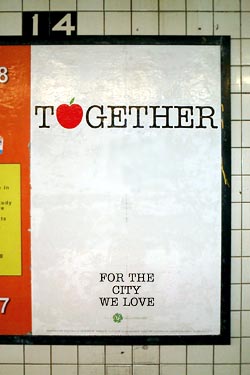 Glaser told the Daily News:
Glaser told the Daily News:
“His new phrase was inspired by the city’s fiscal crisis and the recent threat of a transit strike. Glaser sent City Hall several designs with the slogan, which he says could serve as a ‘rallying cry’ to help New Yorkers bond during tough times.”
When I first saw the new logo in the subway, I was skeptical. As a New Yorker, I will not be bullied into happiness or togetherness. Certainly, when the State sells unity, I wonder who stands to gain. “Community” is often used the gloss over difference and dissent. “You’re either with us, or against us.”
The design, however, is open to interpretation. One could just as easily use it at a block party or mass action. And I’m sure subway riders will note their own impressions on the ad’s generous white space.
As it turns out, the city chose not to use the design. Instead, Glaser and SVA will be publishing it on their own again — the public act of private individual, an educational institution, and its students. SVA also arranged ad space in the subways. The students will distribute the printed posters this weekend.
“The people of NYC seem to be losing that sense of cohesion we felt a year and a half ago,” says Glaser. He hopes the campaign will encourage people to be nicer to each other and may try to use it as a fundraiser for the City to help pay for some of the services being cut. “It’s a drop in the bucket, but it would have symbolic meaning.”
Meanwhile, the city government has plans of its own. Mayor Bloomberg has set up a permanent office and campaign to sell New York to big business and investors and to woo major events. The effort relies less on advertising and more on deals with the private sector and behind-the-scenes lobbying.
It has already brought back Grammy’s and next year’s WNBA All-Star game to New York, but also the Republican National Convention in 2004.
I for one will be out there protesting, together for the city we love.
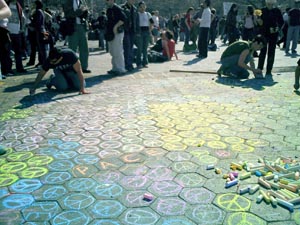
Protestors after the march in New York City yesterday chalked messages around Washington Square Park.
As the U.S. invades Iraq and activists around the world take to the streets, here in New York I’m noticing how the city itself is increasingly used as a medium by the anti-war movement.
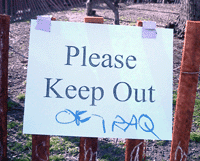 Much of this is nothing new. City streets have always been checkered with posters, graffiti, flyers, and stickers. Subway ads are often annotated with running commentary, sometimes sexual but just as often critical of the ad and advertiser itself (or just blacked out teeth on a too-cheerful model.)
Much of this is nothing new. City streets have always been checkered with posters, graffiti, flyers, and stickers. Subway ads are often annotated with running commentary, sometimes sexual but just as often critical of the ad and advertiser itself (or just blacked out teeth on a too-cheerful model.)
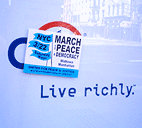 The anti-war movement has taken advantage of all of this. United for Peace and Justice stickers seem to be everywhere — on pay phones, mailboxes, street lamps, walls, and signage. The letters “STOP BUS” on the street are altered to read “STOP BUSH.” In the Baghdad Snapshot Action activists have simply postered ordinary snapshots from Iraq: “Quiet and casual, the snapshots show a part of Baghdad we rarely see: the part with people in it.”
The anti-war movement has taken advantage of all of this. United for Peace and Justice stickers seem to be everywhere — on pay phones, mailboxes, street lamps, walls, and signage. The letters “STOP BUS” on the street are altered to read “STOP BUSH.” In the Baghdad Snapshot Action activists have simply postered ordinary snapshots from Iraq: “Quiet and casual, the snapshots show a part of Baghdad we rarely see: the part with people in it.”
And then there was the march of over 200,000 people down midtown Manhattan yesterday.
But as the war escalates, so do the protests. And so does the reconfiguring of public space. Activists in San Francisco last week shut down traffic throughout the city with autonomous direct actions coordinated online. Activists hauled newspaper kiosks, cafe chairs and tables, and other street furniture into the streets. [article and photos]
What will be the government’s response? Some communities are all too familiar with locked down, fenced in, and video monitored public spaces. Once considered an invasion of privacy, cameras and other measures are increasingly justified as a legitimate response to terrorism. In the name of anti-terrorism, the City recently sought and won a loosening of the law that restricted on police surveillance of political groups. The restrictions were imposed by the settlement of a 1971 lawsuit over harassment of political advocacy groups by the Police Department’s so-called “Red Squad.”
Public amenities and the details of public life are being reshaped elsewhere in the fight against terrorism. In Israel, seating at bus stops is often bolted to the wall (no chair legs to hide things behind), every turnstile will soon have a metal detector installed, and every trash can on the street will be replaced with see-through plastic and wire receptacle. In Washington, D.C., subway trash cans are being replaced with bomb-resistant models. In the Tokyo subway, there are no trash cans at all anymore.
Not to mention Israel’s wall.
This week New York City announced Operation Atlas, additional security measures to try to protect us against terrorist attack during wartime. I’m not opposed to greater inspection of cargo entering the City, but have no doubt that the NYPD will use their new powers to target activists and political dissent. I also note that the plan, which costs $5 million a week comes at a time of severe budget cuts in NYC — and a deficit of nearly $4 billion. Was factored into the costs of the war?
Literature on cities is replete with the metaphor of public space as the site and the physical embodiment of democracy. In the weeks and months ahead, I wonder how our public space will change.
See NYC IndyMedia and Gotham Gazette’s page on New York City and the War.
Indonesian Police Urged to Grow Veggies
“Cash-strapped police shaking down citizens for some of the green stuff is part of daily life in Indonesia. To deter graft, a police chief wants his officers to develop green thumbs instead.
Bogor Police Col. Anton Bachrul Alam said Friday he was encouraging officers to grow tomatoes, lettuce and flowers at home to supplement their often meager income.
‘Their official wages are barely enough to live on. It’s better than extorting people or taking bribes,’ he said.
Alam said a hydrophonics expert would teach officers and their family to grow plants using nutrient solutions rather than soil, making them easier to harvest. A police cooperative will help them sell their crops, he said.
Bogor has about 3,000 policemen who earn on average one million rupiah ($111) per month.
Indonesia’s security forces are notorious for petty graft, running illegal enterprises and taking bribes from drug smugglers and gambling operators.”
Hard to say if this will cut down corruption — there are plenty of rich, well-fed people in the extortion racket. How about some transparency, accountability, or popular oversight to go with the tomatoes and cash?
Still, I love this idea. In addition to the extra income and food, urban gardens have all kinds of environmental and health benefits. And I love the image of hardened cops showing off a proud bouquet of home grown flowers, swapping gardening tips and recipes in the locker room, or picking on the new guy for his clearly inferior eggplants.
- March 16: Over 6,400 candlelight vigils are held in 129 countries. See photos and an interactive map.
- March 17: Window Lights for Peace is launched. An extension of the vigil.
- March 18: Danish Prime Minister Anders Fogh Rasmussen in Parliament in Copenhagen, doused with red paint by a protestor over his government’s backing of U.S. military action on Iraq.

“The linking of the two evils. Unproven by the facts, reality in the image. The Wild West poster does the trick of validating the Bush approach and chosen iconography.”
The Better Rhetor builds on the work of Political Research Associates in this unpacking of the imagery used in a series of Weekly Standard covers.
See also Kate Brigham’s MFA thesis, Decoding Visual Language Elements in News Content, and its prototype Flash piece that allows you to alter design elements of post-September 11 news magazine spreads on the fly. See for yourself how non-verbal messages are expressed, the objectivity of the news is tilted, and the case for war is made by the choice of imagery, its cropping, composition, and color.
Thanks to drapetomaniac for the Better Rhetor link.
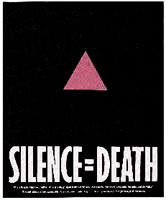 From the Encyclopedia of AIDS:
From the Encyclopedia of AIDS:
“The pink triangle was established as a pro-gay symbol by activists in the United States during the 1970s. Its precedent lay in World War II, when known homosexuals in Nazi concentration camps were forced to wear inverted pink triangle badges as identifiers, much in the same manner that Jews were forced to wear the yellow Star of David. Wearers of the pink triangle were considered at the bottom of the camp social system and subjected to particularly harsh maltreatment and degradation. Thus, the appropriation of the symbol of the pink triangle, usually turned upright rather than inverted, was a conscious attempt to transform a symbol of humiliation into one of solidarity and resistance. By the outset of the AIDS epidemic, it was well-entrenched as a symbol of gay pride and liberation.
In 1987, six gay activists in New York formed the Silence = Death Project and began plastering posters around the city featuring a pink triangle on a black background stating simply ‘SILENCE = DEATH.’ In its manifesto, the Silence = Death Project drew parallels between the Nazi period and the AIDS crisis, declaring that ‘silence about the oppression and annihilation of gay people, then and now, must be broken as a matter of our survival.’ The slogan thus protested both taboos around discussion of safer sex and the unwillingness of some to resist societal injustice and governmental indifference. The six men who created the project later joined the protest group ACT UP and offered the logo to the group, with which it remains closely identified.
Since its introduction, the ‘SILENCE = DEATH’ logo has appeared in a variety of manifestations, including in neon as part of an art display and on a widely worn button. It was also the forerunner of a range of parallel slogans such as ‘ACTION = LIFE’ and ‘IGNORANCE = FEAR’ and an entire genre of protest graphics, most notably including a bloodstained hand on a poster proclaiming that ‘the government has blood on its hands.’ Owing in part to its increasing identification with AIDS, the pink triangle was supplanted in the early 1990s by the rainbow as the dominant image of ‘gay pride.’ By force of analogy, however, the rainbow itself has, in some countries, become an image associated with AIDS.”
via ACT UP NY:
“There was also the SILENCE=DEATH Project, which was a group of men who had started meeting a year and half before [ACT UP was started], including Avram Finklestein, Oliver Smith, and Chris Lione. They were a whole group of men who needed to talk to each other and others about what the fuck were they going to do, being gay men in the age of AIDS?! Several of them were designers of various sorts—graphic designers—and they ended up deciding that they had to start doing wheat-pasting on the streets, to get the message out to people: ‘Why aren’t you doing something?’ So they created the SILENCE=DEATH logo well before ACT UP ever existed, and they made posters before ACT UP ever existed, and the posters at the bottom said something like, ‘What’s really happening in Washington? What’s happening with Reagan and Bush and the Food and Drug Administration?’ It ended with this statement: ‘Turn anger, fear, grief into action.’ Several of these graphic designers were at that first evening that Larry spoke.”
Big ’up to v-2.
Hydroelectricity without the human rights and environmental disasters of dams? Maybe...
“Tidal energy exploits the natural rise and fall of coastal tidal waters caused principally by the interaction of the gravitational fields of the Sun and the Moon. Some coastlines, particularly estuaries accentuate this effect creating tidal ranges of up to 11m.”
Active tidal generators exist in Hammerfest in Norway, Annapolis in Canada, in France in the estuary of La Rance near St. Malo, and Kislaya Guba on the White Sea in Russia. This article summarizes a U.S. effort.
...
“Professor Thorstein Sigfusson, of the University of Iceland, says [the thermo-electric effect] works by translating the difference between the temperature of hot and cold water into energy....
In between the hot and the cold side are crystals made of semi-conductors. As the heat is transferred through these crystals part of it is converted from heat energy into electric energy.
Professor Sigfusson said there was potential for using all sorts of excess heat to fuel Thermators.” (BBC)
...
Japanese researchers are working on an experiemental power plant that produces both power and clean drinking water. From the New York Times:
“The university is preparing to build an experimental power plant off the coast of Palau that brings up cold seawater from the depths of the sea to an evaporator chamber near the ocean surface.
As the water is heated by the surrounding warm surface water, it releases ammonia gas, which then drives the system’s power generator...
Meanwhile, the heated water would be transferred to a separate low-pressure chamber where it boils at a lower temperature, producing steam, which would be condensed and collected as fresh water for human consumption, leaving salt crystals behind...
‘It works well especially in the western Pacific, where the temperature difference between the ocean’s surface and deep seawater is’ as much as 43 degrees Fahrenheit, he said. ‘It is environmentally sound.’”
page 1 2 3 4 5 6 7 8 9 10 11 12 13 14 15 16 17 18 19 20 21 22 23 24 25 26 27 28 29 30 31 32 33 34 35 36 37 38 39 40 41 42 43 44 45 46 47 48 49 50 51 52 53 54 55 56 57 58 59 60 61 62 63 64 65 66 67 68 69 70 71 72 73 74 75 76 77 78 79 80 81 82 83 84 85 86 87 88 89 90 91 92 93 94 95 96 97 98 99 100 101 102 103 104 105 106 107 108 109 110 111 112 113 114 115 116 117 118 119 120 121 122 123 124 125 126 127 128 129 130 131 132 133 134 135 136 137 138 139 140 141 142 143 144 145 146 147 148 149 150 151 152 153 154 155 156 157 158 159 160 161 162 163 164 165 166 167 168 169 170 171 172 173 174 175 176 177 178 179 180 181 182 183 184 185 186 187 188 189 190 191 192 193 194 195 196 197 198 199 200 201 202 203 204 205 206 207 208 209 210 211 212 213 214 215 216 217 218 219 220 221 222 223 224 225 226 227 228 229 230 231 232 233 234 235 236 237 238 239 240 241 242 243 244 245 246 247 248 249 250 251 252 253 254 255 256 257 258 259 260 261 262 263 264 265 266 267 268 269 270 271 272 273 274 275 276 277 278 279 280 281 282 283 284 285 286 287 288 289 290 291 292 293 294 295 296 297 298 299 300 301 302 303 304 305 306 307 308 309 310 311 312 313 314 315 316 317 318 319 320 321 322 323 324 325 326 327 328 329 330 331 332 333 334 335 336 337 338 339 340 341 342 343 344 345 346 347 348 349 350 351 352 353 354 355 356 357 358 359 360 361 362 363 364 365 366 367 368 369 370 371 372 373 374 375 376 377 378 379 380 381 382 383 384 385 386 387 388 389 390 391 392 393 394 395 396 397 398 399 400 401 402 403 404 405 406 407 408 409 410 411 412 413 414 415 416 417 418 419 420 421 422 423 424 425 426 427 428 429 430 431
[ Back ]
[ Next ]



